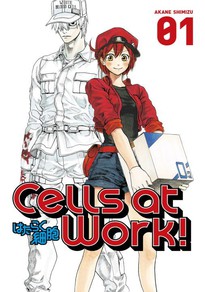Review
by Rebecca Silverman,Cells at Work!
GN 1
| Synopsis: |  |
||
Inside of your body, your blood cells work to keep you healthy by combating germs and bacteria that try to enter through your nose, mouth, or open wounds. Each cell has a specific purpose, from the red blood cells to the different types of white blood cells to the platelets. Come step inside your veins and see what a cell's daily life is like! |
|||
| Review: | |||
First there was Moyasimon, making bacteria cute. Now there's Cells at Work!, anthropomorphizing blood cells as diligent workers, living inside little towns in your veins. Both manga have shared educational goals, but Cells at Work! specifically focuses on the human immune system, and if I'd had this book during biology class in middle and high school, I probably would have been a lot more interested in the subject. While it can be a little unsettling to think that there's a colony of teeny tiny people running around under your skin, Cells at Work!'s first volume is still an awful lot of fun as it makes science into an action manga. The main protagonists of the story are a red blood cell and a white blood cell. Neither have names, although both have distinct appearances separate from others of their kind, as well as their own identification numbers. Red Blood Cell AE 3803 is a cheery young woman who works to carry nutrients through the bloodstream to organs that need it. She's pretty new at her job, as evidenced by the fact that she can't find the lungs to save her life, but she's a hard worker and wants very much to succeed. White Blood Cell 1146 is an older and more competent young man, always one of the first to arrive on the scene by slipping between cell walls. Despite his decidedly scary appearance, he's a sweet guy, and he genuinely seems to like Red as they keep meeting up despite the sheer number of other blood cells. The fact that the story centers on these two and their strange form of cellular kismet gives the otherwise disconnected chapters, each about fighting a separate threat, a more cohesive feeling than they might otherwise have had. Of course, it also sets up a scenario where Red is almost always a damsel in distress to White's savior, but that's partially alleviated by the fact that there are cells of both colors in both male and female form; if all white blood cells were male and all red blood cells female, it would be a bigger issue. Creator Akane Shimizu does a good job of making each chapter both entertaining and educational, using the tropes and varied art styles of shounen action manga to tell the story while dropping in scientific facts through both dialogue and informational text boxes. The various “villains” of the story often look like they've escaped from Yu-Gi-Oh! or Saint Seiya, especially the actual germs, like those that cause pneumonia or meningitis. Cedar allergens look like blobby ghosts, with various parts of the creatures acting like booby traps as the cells try to fight them off. The cells themselves appear to be fairly typical manga characters, with the white blood cells looking almost uniformly creepy, killer T cells like buff military types, and most of the cells in charge of relaying information taking on the appearance of office workers. (There is one memorable visual homage to Hiroaki Arai's art when a naïve T cell becomes activated.) The body is largely drawn as a collection of small towns linked by covered roads, with valves as one-way doors. It may not be anatomically perfect (or plausible), but it works to get the point across. In some ways, that sums up this entire volume – it isn't necessarily the most logical way to present the information, but it does give readers an understanding of how blood cells work within the body. If you look closely, you can see that the red blood cells reverse their jackets depending on if they're carrying oxygen or carbon dioxide, while all of the various white and T cells wear variations on the same uniform. Platelets, the smallest of the cells, are drawn as children, which definitely gets the point across, and when red blood cells are carrying nutrients, they have baskets stuffed with food. Shimizu runs into a little more trouble with strictly scientific information, as there's a lot of repetition in the text boxes and dialogue, which makes reading drag a little. On the other hand, repetition is good for remembering, so that may make it work better in an educational context. Cells at Work! is far more entertaining than it ought to be. Both Red and White are likable characters, and imagery such as a B cell with a fireman-style antibody sprayer or sneezes visualized as torpedoes (what kid doesn't want to think that every time they sneeze a torpedo shoots out their nose?) help make the story exciting. Whether you have an interest in learning about the immune system or not, this is an enjoyable read. It's the most fun you'll have in biology lessons since that one kid figured out how to make the dead frog twitch on the dissecting table. |
| Grade: | |||
|
Overall : B+
Story : B
Art : B+
+ Fun artistic tributes, story is entertaining and engaging, really teaches you about the immune system |
|||
| discuss this in the forum (9 posts) | | |||
| Production Info: | ||
|
Full encyclopedia details about Release information about |
||